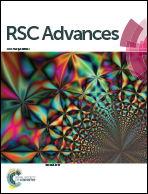DNA based signal amplified molecularly imprinted polymer electrochemical sensor for multiplex detection†
Abstract
Molecularly imprinted polymers (MIPs) have been widely used as sensitive recognition elements in chemical/biological sensors. Motivated by the urgent need of amplified and multiplexed analysis, the unique advantages of molecular imprinting based electrochemical sensors (MIECSs), herein we first developed a DNA based signal amplified MIECS for multiplex detection of folic acid (FA), folate receptors (FRs), Hg2+ and DNA. With folic acid as the template molecule of the molecularly imprinted polymers, FA was detected directly. Due to the specific binding with FA, FRs could then be detected indirectly. Furthermore, with the specific effects of thymine–Hg2+–thymine or complementary DNA bases, by the cleavage of exonuclease III (Exo III) towards single strand DNA, Hg2+ and DNA were further detected in an amplified way through template molecule cyclic release from the DNA structure. The universal sensor gave satisfactory detection limits for folic acid, folate receptors, Hg2+ and DNA at 3 × 10−8 M, 0.3 ng mL−1, 3.45 pM, 40 nM, respectively. It also demonstrated excellent regenerability, reproducibility, and stability. The proposed strategy may open the road for the development of DNA based multiple target MIP sensors by the combination of the unique characteristics of DNA and MIPs.


 Please wait while we load your content...
Please wait while we load your content...